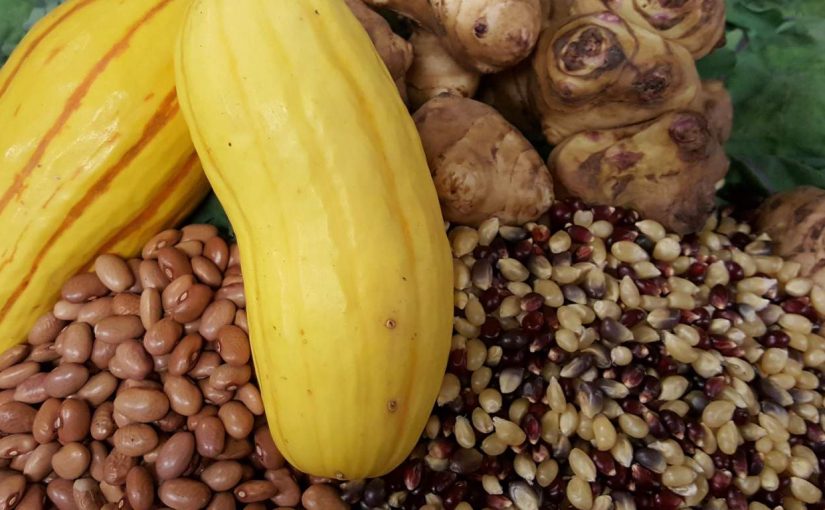Native vs. non-native – that a subject that is brought up frequently on our forums and one we have to discuss at length. However, I thought I’d take it from a different direction this week, a little diversion if you will, seeing as we are just a week away from our American celebration of Thanksgiving that centers around food – much of it native to the United States.
It is a holiday that is quintessentially American (or North American, since our Canadian friends also have their own Thanksgiving). A commemoration of not only the arrival and survival of the pilgrims in Plymouth in 1621, but of our thankfulness for what we have. It is a time for us to gather with family or friends and reflect upon our blessings.
While, much to my chagrin (and that of many others), Thanksgiving seems to have been swallowed up by the Christmas “season” and you can even go shopping for more stuff (an abomination, for sure) on a day when we are supposed to be thankful for what we have, it is still a day celebrated by many.
Turkey, dressing, potatoes, fresh bread rolls and pumpkin pie are the traditional fare for the celebration these days, but they are a far cry from what the original feast shared by the pilgrims and American Indians would have featured.
Historians agree that, while the feast was probably meat-heavy, turkey was probably not on the menu. It just wasn’t as popular a food item as it is today. Most agree that the original feast featured venison, with some waterfowl (goose or duck) and seafood (shellfish like oysters are a definite, maybe even eels or other shellfish).
I don’t think I’m alone in saying that I like the side dishes better than I like the actual turkey. There’s the dressing (or stuffing, depending on your preparation or colloquial terminology), mashed potatoes, sweet potatoes, and my aunt’s seven-layer salad that’s usually more mayo and bacon bits than vegetation.
The produce dishes at the first Thanksgiving would have been vastly different than the modern day smörgåsbord that we prepare. Experts agree that the majority of dishes would have been from native plants and indigenous crops grown by the local tribes, with a few ingredients showing up from the pilgrims’ gardens.
First off, the absence of wheat flour, sweetener and flour would mean the lack of the classic dessert…pumpkin pie. It is hard to imagine a lack of pumpkin while we live in a time in which we are surrounded by pumpkin spice everything (though mostly artificially flavored).
Sugar would have been too expensive to purchase for the voyage, and other sweeteners would have been limited to maple or other tree syrups. (Colonists had not yet brought over the honey bee, which is a European immigrant itself).
This is not to say that there wasn’t squash. There were squashes, including pumpkins, as part of the native diet at the time having spread from their origins in Mexico and Central America . They were likely included in the feast, but either boiled or roasted, and unsweetened.
Beans would have probably been one of the dishes, as well. The Natives Americans ate beans both in dry and green form, but at a fall feast, the beans were likely the dried variety and cooked into a soup or stew. Corn was also a feature of the first Thanksgiving, but not sweet corn (which didn’t make an appearance until much later). The corn would have been a flint type (similar to popcorn) that would have been cooked into porridge or used as a bread.
Native tree nuts, such as walnuts, chestnuts and beech nuts could have also been used in the preparation of dishes. There isn’t any written record of the native cranberry or blueberry being used, either, but they would have been abundant in the area. They likely wouldn’t have caught on in popularity until sweeteners such as sugar from Europe or honey was available to dull their acidic bite, but the dried fruits could have been used in preparations of some of the meat. If there was a salad, watercress could have been used if an early frost hadn’t wiped it out.
The pilgrims had brought with them from Europe various seeds, including herbs and onions, that could have been used to flavor some of the dishes. They may have also brought things like turnips and carrots that could have been available for the first feast (though there isn’t any direct written proof).
One native food that would have most likely been on the first Thanksgiving table is the sunchoke (Helianthus tuberosus), or Jerusalem artichoke. Fallen out of favor for some time, the sunchoke is making its return to many gardens.

A true native food source, the sunchoke is the tuberous root of a species of sunflower (you may even see them growing on roadsides in the fall). The rhizome is roasted or boiled and has a nutty, starchy, potato-like texture and flavor. If you want to grow it, just remember that it is a perennial that will readily spread in the garden. These would have been the closest things to a potato dish the first celebrants would have eaten — we were still a long way away from bringing the potato from South America and the sweet potato from the Caribbean. (Botanist’s note: What we eat are sweet potatoes [Ipomea batatas], not yams [Dioscorea sp.], despite the insistence of canning companies. They aren’t even in the same family.)
So as you sit down for your Thanksgiving feast, be thankful for the blessings in your life and for the leaps and bounds our food options have improved over the past 400 years. Also be thankful for butter, flour, and sugar so you can have your pumpkin pie.
